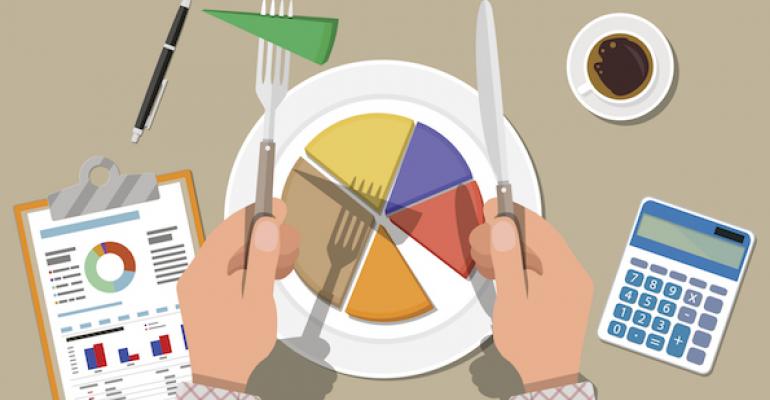Sponsored by Dinova
We recently reported on the growing business travel economy, particularly food & beverage (which is now the second largest expense category, tied with airfare.) Given the upward trajectory in travel spending, we wanted to know: how is the restaurant industry responding?
In conjunction with Penton Publishing (NRN), we surveyed about 400 restaurants of all sizes and types—from stand-alone fine dining establishments to national casual chains—and, despite many restaurants acknowledging the importance of business diners to their bottom lines, surprisingly few were actively marketing to them (or even tracking corporate expenditures.)
The respondents’ overall lack of focus on business diners is curious, given that in 2016 alone, domestic business travel accounted for $547 billion in spending (roughly 3% of the U.S. GDP.) The bottom line: restaurants’ efforts to court business customers has not kept up with the burgeoning business travel economy. Restaurants who can effectively market to business travelers stand to gain a competitive edge, and profit royally.
Business strategies: focus on catering, service options
Overall, restaurants seem to be experimenting with different service models, embracing the “Uberization” of the restaurant industry and growing demand for quick service. One area that’s seen particular growth is catering; 43% of restaurants surveyed increased their catering focus in the past year, and 46% reported an increase in catering sales.
Most of the respondents (8 in 10) offered patrons options other than dining in, indicating a shift toward more diverse service options. Restaurants cited takeout (83%), delivery (29%) and online ordering (28%) as some of the other options available to their customers.
While only about a fourth of restaurants reported using a third-party online delivery app, a number of different apps were listed. Most prevalent were GrubHub (31%), Uber Eats (28%), Postmates and ChowNow (each at 8%.)
Most restaurants agree: business diners are valuable
While some of the restaurants surveyed (10%) simply didn’t know what percent of their clientele business diners accounted for, many seemed to recognize these diners’ significance to their businesses. More than half (53%) of restaurants believed that business dining accounted for at least 25% of their business.
Restaurateurs seemed split as to whether business diners spent more than other customer types. About 40% estimated that business diners did spend more, while 36% said they spend the same; however, just 14% of restaurants reported actually tracking or analyzing corporate credit card spending.
One thing that most restaurants agreed on: the value of repeat business diners. Nine out of 10 restaurants surveyed indicated that these customers were either “extremely valuable” or “very valuable” to their businesses.
So, did the respondents assume correctly? Other studies have shown that business diners are, in fact, more lucrative, for a couple of reasons. By analyzing trends in expense account spending data, we’ve found that these customers spend 25-100% more per visit than non-business customers. They also tend to splurge on more higher profit items, like appetizers desserts, and alcohol.
Marketing to business customers: dated tactics and missed opportunities
When it came to targeting business diners specifically, surprisingly few restaurants surveyed had a specific marketing strategy. Just 1 in 4 said they marketed directly to these customers—a surprising fact, given the perceived business value of business dining and catering that the survey also found. For the roughly 25% that did say they marketed to businesses, tactics varied widely, from door-to-door and online networking to direct mail and special menus.
When asked about targeting business diners specifically, surprisingly few restaurants surveyed had a specific marketing strategy. Given the perceived business value of business dining and catering found in the survey, just 1 in 4 said they marketed directly to these customers. For the roughly 25% that did say they marketed to businesses, tactics varied widely, from door-to-door sales calls and online networking to direct mail and special menus.
When we asked the restaurants, “What makes a customer a ‘business diner?,” the wide range of responses signaled a lot of uncertainty; some looked for lunch hour patrons with badges around their necks, while others thought business diners were the ones who were “in a hurry.” None of their answers were wrong, of course; nowadays, it’s simply hard to tell which of your customers are dining on business.
Less than half (40%) of restaurants said they had a loyalty program; ROI, cost, and technology seemed to be the deciding factors for adopting a loyalty program. Respondents listed “trackable results” as the most important feature in a loyalty program, with 75% rating it as “extremely important” or “very important.” Other top factors included customer demographics (60%), “No extra point of sale technology” (56%) and no upfront costs (56%).
One loyalty program to rule them all
Although restaurateurs in the survey seemed skeptical about the effectiveness of loyalty programs for attracting business customers, Dinova’s loyalty program is different. It addresses all of the top concerns that restaurant survey participants named.
- Trackable results: With Dinova, you’ll be able to see exactly how much incremental revenue came from joining the network.
- Customer demographics. In-network businesses include some of the nation’s largest and most profitable companies, full of expense account diners and travelers. There’s no need for you to identify them—we simply bring them to you.
- No extra point-of-sale technology. There’s no need to learn new technology, train your staff, or use special loyalty cards. The program works in the background, tracking in-network expenditures using American Express corporate card data.
- No upfront costs. There are no upfront fees to join Dinova, and it’s self-funding!
And, because 70% of the business Dinova delivers is from business travelers outside of your restaurant’s local market, the revenue boost you’ll see is all incremental.
Ready to gain a competitive edge, and capture a larger slice of the growing expense account dining segment? Take the next step here.




